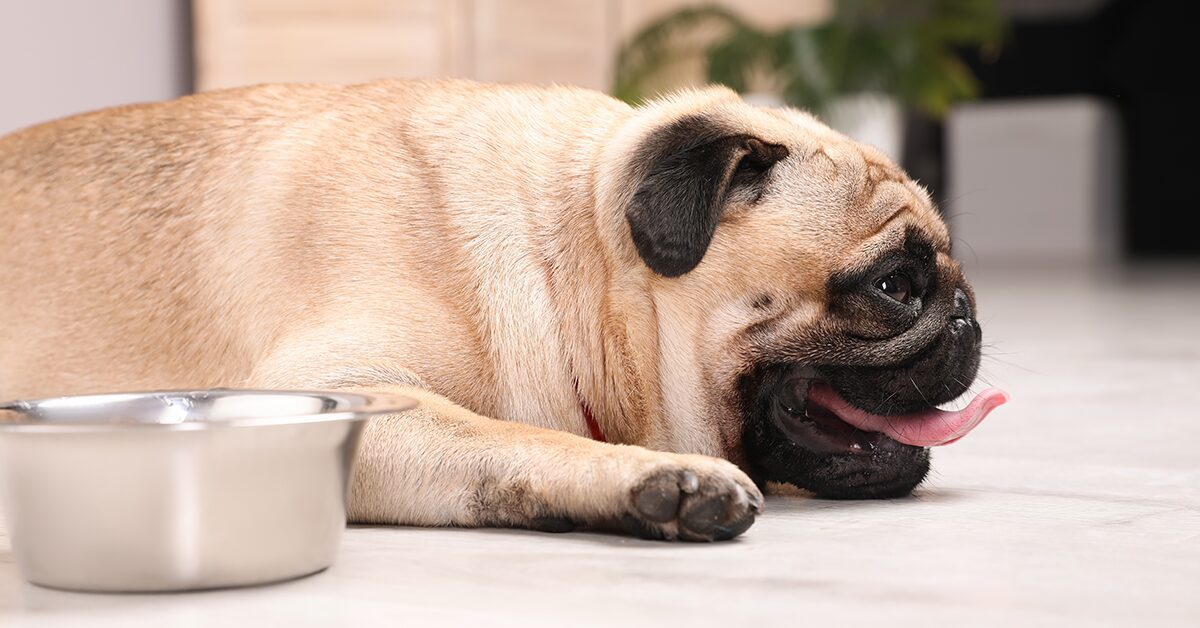Key Points
- Signs of dehydration in dogs include lethargy, excessive panting, loss of elasticity in skin, loss of appetite, dry nose, sticky gums, and sunken eyes.
- If you suspect your dog is dehydrated provide them with a clean bowl of water and cool environment. If symptoms do not improve, call your vet!
- To prevent dehydration in your dog, monitor their fluid intake, carry around a portable water bowl, and make water more appetizing by mixing in some broth or a few ice cubes.
- Ideally, your dog should be drinking about one ounce of water per pound of body weight.
Warm, sunny, summer fun doesn’t have to mean a dehydrated dog – but as the temperatures rise, you’ll probably notice your pup becoming a bit more thirsty.
An extra tired pup who is exhibiting excessive panting usually needs a trip to the water bowl – but when does this extend past normal thirst and into dehydration?
Dog dehydration 101
Dog dehydration is very similar to when we pet owners neglect to drink enough water for our bodies to function efficiently. If our pups don’t drink enough water, they’ll struggle to stay hydrated. Some water loss is normal in a healthy dog, from defecation, urinating, normal blood flow, and even panting. However, if your dehydrated dog loses more water and electrolytes than they are taking in, their body will struggle to keep up.
What are the signs of a dehydrated dog?
Look out for these seven signs of dehydration in your dog:
- Low energy or lethargy — Many pups tend to be sleepy and cuddly, but if it starts to exceed the usual amount, keep a close eye on them.
- Loss of elasticity in your dog’s skin — If you pull and release your dog’s skin and it doesn’t go back to its normal position, it’s a pretty sure sign that your dog is suffering from at least mild dehydration.
- Dry nose — If your pup isn’t taking in enough fluids, moisture from the nose dries up, too.
- Excessive panting — Heavy panting can be a sign of dehydration and potentially heatstroke.
- Loss of appetite — We know how food-driven our dogs can be; if there’s a sudden change in your pup’s appetite, take note.
- Xerostomia or sticky gums — Take a closer look at your dog’s gums and look for signs of their saliva thickening up and taking on a pasty consistency.
- Sunken eyes — this is a sign of severe dehydration and you should call your vet ASAP.
Causes of dehydration in your pup
There are many possible causes of dog dehydration but some of the most common are:
- Increased body temperature — If your dog is running around in hot weather, their body temperature could significantly increase which may cause a loss of fluids.
- Dietary issues — If your dog is experiencing dietary issues, or if they do not have access to clean water, they may be drinking less water.
- Experiencing unusual bodily functions — If your dog has diarrhea or persistent vomiting, they are also experiencing significant fluid loss.
Luckily, the more serious causes of dehydration are less common. That being said, dehydration can also be a symptom of a serious condition such as heatstroke, kidney disease, or kidney failure. If you find that your dog is displaying severe symptoms, such as vomiting, passing out, or prolonged sleeping, make sure to seek veterinary care immediately.
How to help a dehydrated dog
If you’ve determined that your dog is dehydrated, your first step is to replace the fluids that they’ve lost. Provide your dog with access to clean water immediately. However, too much water too quickly could make them vomit and further dehydrate your pup, so monitor their fluid intake!
A common rule of thumb is to provide a small breed dehydrated dog with about 1/8 cup of water per hour and a large breed dehydrated dog with about 1/4 cup of water per hour. Another good replacement for this is an ice cube. This is a great way to regulate how quickly your dog is rehydrating. Also make sure to provide your pup with a comfortable, cool environment to recoup in.
If signs do not improve or worsen, make sure to call your vet for assistance.
When you should contact your veterinarian
As a pet owner, seeing your pooch struggle with severe dehydration can be scary. The most important thing to do if your pet is exhibiting extreme dehydration symptoms is to call your vet. This dehydration could lead to kidney failure, primarily because the sodium, potassium, and chloride found in water are essential to the function of your dog’s internal organs. Your vet can treat this condition quickly with intravenous fluid injection. If left untreated, severe cases of dehydration can lead to unconsciousness and even death.
How to prevent dehydration
Ideally, your dog should drink about one ounce of water for every pound of body weight. Although it’s difficult to have eyes on them at all times, try to monitor your dog’s water intake, and always provide them access to a full clean water bowl.
Carrying a portable water bowl with you on walks can also help promote better hydration. Replacing your dog’s water regularly will keep your dog interested in drinking. If water seems unappetizing to your pooch, consider adding an ice cube to the water, or even a small amount of meat to help with flavor.
Your vet can diagnose and treat underlying causes of dehydration, in addition to providing care that can help prevent future issues. It’s important to bring your dog to the vet for regular visits so they can understand what’s normal and what’s not.
FAQs
What can I do to help my dehydrated dog?
If your dog is severely dehydrated, the first thing you should do is contact your vet. For mild cases, the first step is to try to get your pup to start drinking small amounts of water every few minutes. You could also get your pup Ringer’s lactate (an electrolyte replacement fluid). If they’re still suffering from dehydration, you can call your vet to get advice.
How much water should I give my dog?
Drinking water too fast could make things worse for your pooch. Because of this, small amounts of water (about an 1/8 cup per hour for small breeds, and up to a 1/4 cup per hour for larger breeds) or an ice cube should be given to control their intake.
What happens if a dog suffers from severe dehydration?
Serious cases of dehydration could lead to internal organ failure, as well as impaired muscle function. This should be addressed by a vet ASAP in case loss of consciousness or kidney failure occur.
When unexpected accidents or illnesses strike, getting your pup the best care possible is a top priority–but vet bills can get out of hand. That’s why Pumpkin Dog Insurance plans offer up to 90% cash back on eligible vet bills for accidents and illnesses.
- https://pets.webmd.com/dogs/dog-panting-heavily#:~:text=It's%20normal%20for%20dogs%20to,experienced%20a%20life%2Dthreatening%20trauma.
- https://www.northeast-vet.com/site/pet-care-blog-plains-vet/2021/01/25/dehydration-in-dogs-causes-symptoms-treatment#:~:text=The%20most%20obvious%20sign%20of,sign%20of%20dehydration%20in%20dogs.
- https://www.charlotte.carolinavet.com/site/charlotte-emergency-vet-blog/2021/04/19/signs-dehydration-dogs#:~:text=Dehydration%20happens%20if%20your%20dog,It%20may%20even%20be%20fatal.




